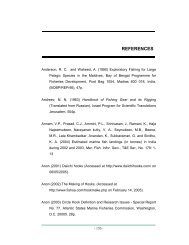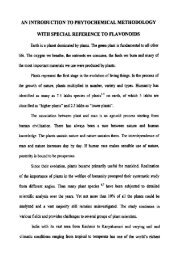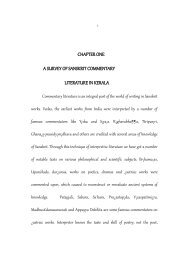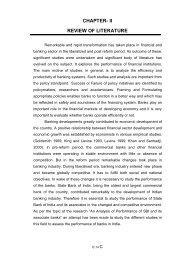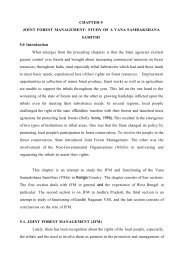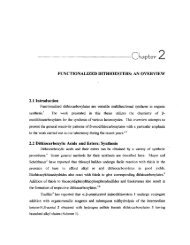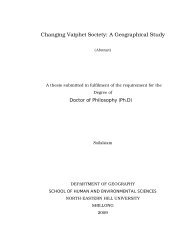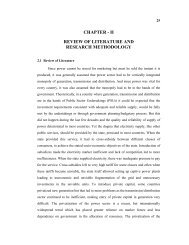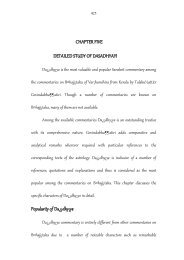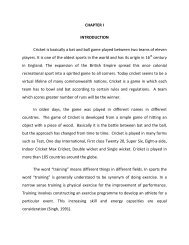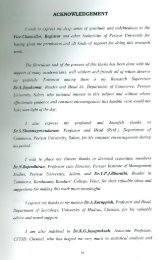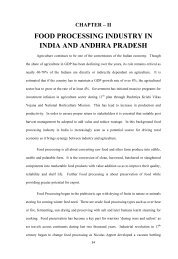CHAPTER V REFUTATION OF BAUDDHA PHILOSOPHY
CHAPTER V REFUTATION OF BAUDDHA PHILOSOPHY
CHAPTER V REFUTATION OF BAUDDHA PHILOSOPHY
Create successful ePaper yourself
Turn your PDF publications into a flip-book with our unique Google optimized e-Paper software.
<strong>CHAPTER</strong> V<br />
<strong>REFUTATION</strong> <strong>OF</strong> <strong>BAUDDHA</strong><br />
<strong>PHILOSOPHY</strong><br />
172
<strong>CHAPTER</strong> 5<br />
<strong>REFUTATION</strong> <strong>OF</strong> <strong>BAUDDHA</strong> <strong>PHILOSOPHY</strong><br />
Introduction.<br />
áa´kara refers to the three main schools of Buddhism. They<br />
are Sarv¡stivada, Vijµ¡nav¡da and á£nyav¡da. The Sarv¡stiv¡dins<br />
173
accept the reality of both the outside and the inside world 1 . The<br />
Vijµ¡nav¡dins maintain the theory that thought alone is real 2 . The<br />
á£nyav¡dins agree that everything is void 3 , but all of them agree that<br />
everything is momentary. According to Nataliya Ì¿ayeva, “As shown<br />
by the Advaitist, the Buddhists are classified under different sects in<br />
accordance with their interpretation of reality. Some maintain that<br />
everything exists ‘Sarvo ¡sti iti sarv¡stiv¡di, others allow for the<br />
existence of consciousness , that is , Vijµ¡nav¡da, and there are some<br />
who claim everything to be void, that is , á£nyav¡da. The general<br />
definition applied by áa´kara to all Buddhist schools is derived from<br />
the term Vin¡¿a, destruction, annihilation; it points out the core of<br />
174
the teaching, namely, the idea of the non-existence of Ëtman as a<br />
separate ontological reality. Therefore, Buddhism is determined by<br />
him as Vain¡¿ikamata, which can be roughly rendered as a teaching<br />
about non-existence 4 ”. áa´kara has been regarded by his opponents<br />
as a Crypto-Buddhist (Pracchanna-Bauddha). Many opponents of<br />
áa´kara regarded him as a Crypto Buddhist, because there are<br />
parallels between Advaita Ved¡nta and Mah¡y¡na Budhism,<br />
especially in connection with the principle of avidya and two truthsthe<br />
Param¡rthika (the absolute) and the Vyavah¡rika (the practical).<br />
Both these systems accept avidya as that which is to be removed, and<br />
both of them accept the twofold division of avidya-cognitional and<br />
175
conational aspects. But áa´kara gives more emphasis to investigation<br />
and inquiry. But Bauddha gives more emphasize to mind control<br />
and morality. Avidya , in its cognitional aspect , has provided a<br />
‘path’. According to Bauddha concept of Avidy¡: ‘path’ is the<br />
practice relating to prajµa. According to áa´kara, the path consists<br />
of investigation into the Ved¡nta texts , and the inquiry into<br />
Brahman. Against the Bauddha notion of momentariness, áa´kara<br />
emphasized on eternity of fundamental principle. These are the<br />
points of difference between áa´kara and Buddhists. The following<br />
concepts of Bauddha philosophy are refuted by áa´kara. They are :<br />
(1)theory of causation , (2) the concept of Ëk¡¿a, (3) the theory of<br />
176
origination of an entity from absence, (4) the concept of self intuition<br />
, (5)the concept that object entity and cognition are the same, (6) The<br />
concept that all worldly cognitions are unreal like dream, (7) the<br />
concept of svasamvedana pratyakÀa, (8) the concept of V¡sana,<br />
(9)the concept of alayavijµ¡n as the abode of v¡sana, and (10)the<br />
concept of antarjµeyar£pa as object entity.<br />
Sarv¡stiv¡da<br />
The Sarv¡stiv¡da school of H¢nay¡na Buddhism is in its<br />
approach realistic. It is divided into two: Sautr¡ntika and<br />
Vaibh¡Àika. The Vaibh¡Àika attaches itself to Vibh¡Àa ,a<br />
177
commentary on Abhidharma work and it may be called<br />
presentationalism (The doctrine that in perception the mind has<br />
immediate cognition of the object). The Vaibh¡Àika-s maintain the<br />
independent existence of mind and matter.<br />
The Sautr¡ntik¡s are attached to s£tra and they may be called<br />
advocates of representationalism. (The doctrine that perceived<br />
objects as only a representation of real external objects). The<br />
Sautr¡ntik¡s maintain the theory that all external things are<br />
inferable. But the scholars agree that both these schools are equally<br />
realistic. áa´kara refuted theses two schools bearing the name of<br />
Sarv¡stiv¡da.<br />
178
Refutation of the Buddhist theory of causation<br />
The Buddhist theory of causation is called Prat¢tya-s¡mulpada<br />
or the theory of dependent origination. Regarding the concept of<br />
causation, the Sarv¡stiv¡da holds the view that all constructed things<br />
are independently originated 5 . The famous Buddhist thinker<br />
Kamala¿ila says that it is the chief jewel among all the teachings of<br />
the Buddha. According to Dr. Vijaya Rani, this theory has a wide<br />
scope. It covers the problem of causal relationship, the theories of<br />
momentariness, of disconnected flow, of no soul, of ¿£nyata and so<br />
forth 6 . The effect elements come forth only when the cause element is<br />
there (dharma-sthitita).<br />
179
According to áa´kara, the term samud¡ya 7 can be interpreted<br />
in two ways: (1) the evolutes having as cause the elements of fire,<br />
water, earth and wind, and (2) the mentals having thought as their<br />
cause 8 . The Sarv¡stiv¡dins and their followers recognize the view that<br />
the external reality is either element or elemental and the internal<br />
reality is either mind or mental. They say that both these together<br />
make up this universe. The external<br />
world is made up of the<br />
aggregation of atoms 9 . These atoms are four kinds i.e., atoms of<br />
earth, i.e., hard, (b) atoms of water, i.e., viscid ,(c) atoms of fire, i.e.,<br />
hot, (d) atoms of air, i.e., mobile. These atoms are gathered together<br />
in to aggregates. With the connection of the internal world, the five<br />
180
personal skand¡s are the cause. They are: r£pa skandh¡, vijµ¡na<br />
skandh¡, vedan¡ skandh¡, samjµ¡ skandh¡ and samsk¡ra skandh¡ 10 .<br />
By the aggregation of these skandh¡s the internal world is produced.<br />
According to áa´kara, the above view of Sarv¡stiv¡da is<br />
unacceptable because no cause is established for the existence either<br />
of the aggregate of elements and evolutes or of the aggregate of<br />
thought and mental 11 . These two types of aggregates can never be<br />
formed at all. The unintelligent momentary atoms and the<br />
momentary skandh¡s cannot form any systematic whole. áa´kara<br />
continually says that if individual atoms could engage in activity on<br />
their own account, then their activity would never cease 12 . So there is<br />
181
no aggregation. Without the aggregation the worldly things cannot<br />
exist. But the Sarv¡stiv¡dins suppose that on the basis of the series of<br />
the dependent origination (prat¢tyas¡mulp¡da) the aggregate can be<br />
formed. Dr Vijaya Rani gives two definitions to Prat¢tyas¡mulp¡da,<br />
i.e., an origination after getting the causes, and an origination after<br />
the destruction of the causes 13 . On the basis of the formation of<br />
aggregates the series of Prat¢tyas¡mulpada can be explained’ 14 . The<br />
series is – avidy¡, samsk¡ra, vijjµ¡na, n¡ma, r£pa, Àad¡yatana,<br />
spar¿a, vedan¡, t¤À¸a, up¡d¡na, bh¡va, jati, jara, mara¸a, ¿oka,<br />
parivedana, dukha, etc 15 . Through this series an uninterrupted chain<br />
of cause and effect is constituted. This chain cannot take place<br />
182
without the aggregates. The Sarv¡stiv¡dins hold the view that the<br />
aggregates are the reality, by the s£tra: itaretarapratyay¡tvatiti<br />
cennolpattim¡tra nimittatv¡t 16 .<br />
áa´kara refutes these concepts of<br />
Sarv¡stiv¡dins. According to áa´kara, the formation of the aggregates<br />
are explained by the mutual causality of the series of dependent<br />
origination. He refutes them by saying that though the preceding<br />
one is the cause of the subsequent one, there is nothing which can be<br />
the cause of the whole of the aggregate. According to him, the atoms<br />
cannot combine themselves even when they are assumed to be<br />
permanent and eternal, because the atoms are momentary<br />
aggregates<br />
without which the nid¡nas would be deprived of an<br />
183
abode. He says that Bauddhas may accept nescience as an efficient<br />
cause for the aggregates, Since the aggregates follow one another in a<br />
series 17 . The aggregates are formed on the basis of nescience, they<br />
follow one another as a series in an endless world. It causes an<br />
aggregate being born distinct from an aggregate, which is born<br />
similar according to rule, or is born either similar or dissimilar,<br />
according to no rule. In the former case, a man could never be<br />
reborn in a different state. In the latter case, he could in an instance<br />
be transformed into something else. áa´kara argues against the<br />
Sarv¡stiv¡da concept of series by asking how aggregates can be born<br />
from other aggregates in an endless series. In that case , liberation<br />
184
would be desired by one but attained by another. So, the series<br />
stands in a relation of successive causality and it cannot be the cause<br />
of the aggregates, and there being no permanent enjoyer, there is<br />
neither any need of the aggregate. The mere existence of the<br />
preceding moment means its causal efficiency. This also cannot be<br />
acceptable because no effect can arise without imbibing the nature of<br />
the cause which is permanent as it continues to exist in the effect<br />
and thus the Bauddha doctrine of momentariness is not acceptable.<br />
Through the commentary of the s£tra –uttarolp¡de ca<br />
p£rvanirodh¡t 18 , áa´kara establishes that the successive causality<br />
spoken of in the series of avidy¡, samsk¡ra etc. is untenable. The<br />
185
Sarv¡stiv¡dins argues that everything is created; the antecedent thing<br />
would already have ceased to exist at the next moment (ulpanna<br />
vin¡Àa) 19 . According to the Abhidhar-mako¿a, “the uninterrupted<br />
succession of moments following one another is duration. The latter<br />
moment is the substitute of the former moment because of<br />
similarity” 20 .<br />
áa´kara refutes this argument thus - it is intended by the<br />
Sarv¡stiv¡din that the entity having a perfected condition in the<br />
previous moment cause of entity in a later moment. This is not<br />
possible, because of the occurrence of connection with a second<br />
moment when there is the hypothesis of the further activity of an<br />
186
entity 21 . áa´kara states that if existence (bh¡va) of the cause be its<br />
activity (vy¡p¡ra) ,then the effect is imbued with the nature of the<br />
cause. The cause lasts for more than one moment and the principle<br />
of momentariness is tresspassed. The Sarv¡stiv¡din say that existence<br />
is its activity 22 . áa´kara refuted the point saying that it is impossible<br />
because of the impossibility of arising of an effect. As that which is<br />
not imbued with the nature of the cause since everything is<br />
momentary, the antecedent thing would already have ceased to exist<br />
at the next moment, when the subsequent thing is created 23 . So it can<br />
be the cause of the other.<br />
187
According to the view Sarv¡stiv¡da, áa´kara says that the cause<br />
and effect can continue to exist without the colouring of the effect by<br />
the cause. áa´kara replies that such a position would bring about<br />
confusion.<br />
áa´kara says that the Sarv¡stiv¡din cannot admit any causal<br />
process issuing from the momentary cause and influencing effect.<br />
The characteristic of cause influences the characteristic of the effect.<br />
That concept cannot be denied by the Sarv¡stiv¡din. If it is still<br />
maintained to be the cause, then one has to accept that existence<br />
comes out of non-existence. For example, the cloth is produced by<br />
the non-existent yarns. Otherwise, one can think that clay can<br />
188
produce the cloth. The doctrine of momentariness would go against<br />
the principle that the effect is the cause in a new form. This principle<br />
shows that the cause existed in the effect, which means that the<br />
process of the causation is not momentary 24 .<br />
According áa´kara, on account of the momentariness of things<br />
‘origination and destruction’’ will be synonymous. A momentary<br />
entity as a product must go through the state of origination,<br />
existence and destruction. So, every entity must have a life span of at<br />
least three moments. áa´kara examines that three alternatives for<br />
explaining the origination and cessation. 1. Svar£pa (entity exists in<br />
its own form). 2. Avst¡ntara (entry existed in another state). 3.<br />
189
Vastv¡ntara (production of an altogether different thing) 25 . The<br />
Abhidharmako¿a also presents the concept of origination and<br />
cessation constitute by the Sarv¡stiv¡dins, through three alternatives,<br />
i.e., a thing in its own form (svar£pa), another state (avast¡ntara)<br />
and altogether different thing (vastv¡ntara) as the characteristics of<br />
dharma 26 .<br />
These alternatives pointed out by áa´kara cannot be<br />
applied logically to the Sarv¡stiv¡dins doctrine. áa´kara says that<br />
according to the first view, the origination and destruction constitute<br />
the own-formation of a given thing. So the origination and<br />
destruction are equivalent to thing itself. According to the second<br />
view, áa´kara’s position that the origination and cessation represent<br />
190
the initial and final stages of the given thing which presuppose an<br />
intermediate stage. Then the given thing will have relation with the<br />
three moments and is no longer momentary. Therefore the<br />
Sarv¡stiv¡da concept is trespassed. According to the last view, the<br />
given thing is altogether disconnected from origination and<br />
destruction. So , it must be regarded as everlasting. Therefore, the<br />
Sarv¡stiv¡da concept is refuted by áa´kara’.<br />
Some Sarv¡stiv¡dins says that the origination and cessation of<br />
a given thing signify merely the perception and non-perception. It is<br />
in opposition to the Sautr¡ntika concept. The Sarv¡stiv¡dins say that<br />
191
“there is no pram¡¸a for the cessation and origination of a given<br />
thing” 27 .<br />
áa´kara refutes this concept and says that if our perception<br />
and non-perception of a given thing constitute the birth and<br />
cessation, one will have to say that these are the characteristics of a<br />
seer, not the characteristic of a given thing. So áa´kara thoroughly<br />
says that the ultimate nature of a given thing is permanent and it is<br />
not momentary 28 .<br />
According to the Sarv¡stiv¡da concept, cause and effect exist<br />
simultaneously at the next moment. That means the cause lasts for<br />
192
more than one moment. This opinion is against the Sarv¡stiv¡da<br />
theory of momentariness .<br />
áa´kara cannot accept the theory of momen-tariness, because<br />
his Advaita principle of eternal entity is contradictory to it. That is<br />
why áa´kara refuted the concept of Sarv¡stiv¡da emphatically.<br />
Refutation of Vaibh¡Àika theory of Destruction<br />
áa´kara criticizes the Vaibh¡Àikas view that the<br />
pratisamkhy¡nirodha, apratisamkhy¡nirodha and ¡k¡¿a are<br />
indefinable, non-placeable and external. áa´kara regards these as<br />
definable, placeable and external. The pratis¡mkhya-nirodha is<br />
193
concerned with the momentary existence of dharm¡-s and is<br />
admitted to have a cause, e.g., when a jar is broken by a man with a<br />
stick. The apratisamkhy¡nirodha is concerned with the cessation of<br />
an entity, e.g., natural decay of things 29 .<br />
The famous Buddhist thinker Vasubandhu defines<br />
pratisamkhy¡nirodha as the cessation of the Sa¿ravadharmas by<br />
means of transcendental knowledge. Yamakami Sogen pointed out<br />
that this is the summon bonum of the Sarv¡stiv¡din who considers it<br />
to be synonymous with nirvana also, the Vijjµ¡nav¡dins consider it<br />
merely as a stage leading to nirv¡¸a 30 .<br />
194
Vasubandhu defines the apratisamkhy¡nirodha as a complete<br />
cessation of the mixing of elements (dharm¡-s) due to the<br />
unavailability of the required conditions 31 .<br />
The famous Buddhist logician Vasubandhu asserts that “the<br />
destruction of existent things is without any cause (¡kasmik¡hetuka);<br />
Because a produced thing has its causes but destruction is only the<br />
negation of existence and hence nothing can be done of that which<br />
itself is non-existent 32 ”.<br />
The Vaibh¡Àik¡-s think that the pratis¡mkhya-nirodha,<br />
apratis¡mkhya nirodh and ¡k¡¿ are non-placeable insubstantial<br />
and indefinable. The destruction proceeded by the mind of entities is<br />
195
known a cessation with understanding. The destruction preceded by<br />
without the mind if entity is known as the apratisamkhy¡nirodha.<br />
The absence of hindrance is known as ¡k¡¿a 33 .<br />
According to áa´kara these two kinds of destruction do not<br />
happen because the series of dependently originated dharm¡-s<br />
cannot be broken, the nid¡n¡s are related to each other as cause and<br />
effect. The nid¡n¡s of dependently originated dharmas must be<br />
inseparably connected with its previous states. So the indefinable<br />
destruction is not possible.<br />
áa´kara argues that these two kinds of destruction cannot be<br />
found in the individual members of the series. In the momentary<br />
196
existence of each member, there is no conscious destruction. It is not<br />
an unconscious destruction also, because the individual member is<br />
not altogether destroyed, e.g., When a pot is destroyed we find the<br />
existence of clay. On account of the heat, the drop of water<br />
disappears and we see it existing in the other form like steam. In<br />
Bauddha concept of vin¡¿a, there is nothing related to any other<br />
form or other substance 34 . So their concept is not accepted by<br />
áa´kara.<br />
In the words of Yamakami Sogen, áa´kara has mistaken in<br />
representing the said two nirodh¡s . áa´kara critically says that the<br />
two kinds of destruction are either the result of perfect knowledge or<br />
197
of the meaninglessness of the path. Thus, both concepts are not<br />
accepted by áa´kara. If we accept the first idea it is against the<br />
Bauddha principle of causeless destruction. If we accept the later<br />
concept, there is the cause of the meaningless of the path. Thus, both<br />
concepts are rejected by áa´kara.<br />
Refutation of the concept of Ëk¡¿a<br />
According to the Buddhist philosophy, pratisamkhy¡-nirodha<br />
and apratisamkhy¡nirodha are indefinable. Refutation of these have<br />
already been described earlier. Then he takes the third entity Ëk¡¿a.<br />
According to the Buddhistic view the Ëk¡¿a is also indefinable. The<br />
indefinability of Ëk¡¿a is refuted<br />
198
y áa´kara in Brahmas£trabh¡Àya 35 . According to Abhidharmako¿a,<br />
the Sarv¡stiv¡dins define ¡k¡¿a as that having for its<br />
measure the absence of tangible .<br />
According to Sarv¡stiv¡dins there are two kinds of ¡k¡¿a: (1)<br />
unconstructed dharma (2) the space as element. The space element<br />
included within the sense base of the visible. Ëk¡¿a as unconstructed<br />
dharma has for its nature non-hindrance .<br />
In áa´kara’s words, like the pratisamkhy¡nirodha and<br />
apratisamkhy¡- nirodha, the ¡k¡¿a is also a given thing. From verse,<br />
¡tman¡h ¡k¡¿a sambh£tah 36 we know that ¡k¡¿a is a substance. As<br />
the Bauddha do not accept the áruti as a pram¡¸a, the anum¡na is<br />
199
also be adopted to prove the substantiality of ¡k¡¿a. Ëk¡¿a is similar<br />
to earth, air, etc. They are recognized to be entities in consequence of<br />
their being the substratum of properties like smell, cold etc, similarly<br />
the ¡k¡¿a, it being the substratum of sound, ought to be recognized<br />
as an entity 37 . Therefore áa´kara refuted the Bauddha concept by<br />
saying that ¡k¡¿a should be definable.<br />
áa´kara refutes the Sarv¡stiv¡da definition of ¡k¡¿a i.e., ¡k¡¿a as the<br />
absence of material flow without hindrance (sapratigha<br />
dravyabh¡vam¡tra). He presents the example of the flying of the<br />
birds in the sky. When a bird flies in ¡k¡¿a, there is the presence of<br />
200
obstruction, hence another bird that may try to fly will find no scope<br />
for doing so. In<br />
this case, anything with the help of which the absence of obstruction,<br />
is specified will itself be the possible entity - ¡k¡¿a, and it will not be<br />
mere absence of hindrance 38 . In the series of question referred to<br />
Baudha dar¿ana, there is a question of “what is the basis of earth”.<br />
They say that the wind is the basis of earth. The next question is,<br />
“what is the basis of wind”. Their answer is the ¡k¡¿a is the basis of<br />
wind. From this we get the conclusion that if ¡k¡¿a is not a given<br />
201
thing the above answer is not correct. Therefore ¡k¡¿a must be an<br />
entity 39 .<br />
Refutation of the origination of object entity from absence<br />
According to áa´kara, the Sautr¡ntikas notion that birth as existence<br />
subsequent to non-existence (abh£tva bh¡vutpada) is questionable.<br />
Their idea is not accepted by áa´kara. Because they do not accept the<br />
permanent and eternal cause of a given thing, but they argue that an<br />
entity<br />
is derived from non-existence. For example, they say that, from the<br />
destruction of a seed a sprout is formed. Like, when the milk is<br />
202
destroyed, the curd is formed, from the lump of a clay a pot is<br />
formed. So the Sautr¡ntikas say that from the absence the entity is<br />
formed.<br />
áa´kara argues against their concept. He says that if a thing<br />
can arise out of absence, then anything can arise out of anything.<br />
áa´kara says that if this theory was true, then no one would have to<br />
exert himself to attain any end, since ends could be attain without<br />
means. If the nirv¡¸a is born from absence there would be the<br />
perfection of the lazy people also because the attainment of absence<br />
is very easy. Therefore áa´kara thoroughly refutes the view that there<br />
should be no evidence to prove that the entity is born from absence.<br />
203
Refutation of Vijµ¡nav¡da<br />
Vijµ¡nav¡da<br />
The Vijµ¡nav¡dins argue for the non-existence of external<br />
objects. In Brahs£tra¿a´karabh¡Àya, áa´kara has presented five<br />
arguments put forward by Vijµ¡nv¡dins to prove the non-existence of<br />
external objects (1) If external objects exist, they are either atoms or<br />
aggregates of atoms. But they can be neither and are therefore nonexistent.<br />
(2) Even those who admit the existence of external objects,<br />
admit different forms of their cognitions. But if forms of cognitions<br />
are admitted, they suffice for the practical purpose of our life, and<br />
204
the existence of external objects becomes unnecessary. (3) Objects<br />
and their cognitions are invariably perceived together. Therefore they<br />
are identical with each other. (4) Waking cognitions apprehend<br />
themselves like dream cognitions. Both are similar to each other.<br />
Both are not produced by external<br />
objects . (5) The variety of pratyayavaicitra is due to the variety of<br />
v¡san¡- vaicitra. These arguments are refuted by áa´kara.<br />
Refutation of self-intuition.<br />
The concept of self intuition of Buddhists is connected with<br />
the non separation of three factors that is subject, object and self<br />
205
intuition. In Pram¡¸a samuccaya, Dinn¡ga proves that these three<br />
factors are inseparable.<br />
According to the concept of the Vijµ¡nav¡dins the jµeya is not<br />
different from jµ¡na. The famous Vijµ¡nav¡di Dharmak¢rti says that<br />
when we see a blue lotus, the blue and cognition of blue are not<br />
different entities. One should recognize their difference as due to the<br />
false cognition. Like the astigmatic seeing the double moon, but the<br />
moon is single.<br />
áa´kara in his commentary on the Brahmas£tra “nabh¡va<br />
upalabdeÅ” 40<br />
tries to deny the dependent object entity of<br />
Vijµ¡nav¡da. He puts forward the five types of the p£rvapakÀins . (1)<br />
206
According to áa´kara the Vijµ¡nav¡dins note that the object entity is<br />
composed of atoms. It is untenable. If object entities are different<br />
from atoms, they can no longer be said to consist of atoms. He<br />
continually says that if they are identical with atoms they cannot be<br />
aggregates. For example, about the objects like posts, there will not<br />
be the notion of atoms etc. There is no collection of atoms such as<br />
posts, etc because of the impossibility of ascertaining the posts etc.,<br />
by means of otherness or non-otherness from atoms.<br />
(2) The Vijµ¡nav¡dins argue that the variety of cognition is<br />
explained only by the variety of sense object. Therefore, the sense<br />
object have a formation similar to their cognitions.<br />
207
(3) In áa´kara’s words, the Vijµ¡nav¡dins argue that the<br />
ascertainment of sense - object and perception are identical.<br />
(4) According to áa´kara Vijµ¡nav¡dins say that consciousness<br />
is to be considered as similar to a dream. The images occur in a<br />
dream without the presence of corresponding object entities.<br />
Likewise in the waking stage also the images occur without the<br />
eternal object entities. For example, the concepts of gandharva<br />
nagara, marumar¢cika, magic, etc, are only the imaginary subject<br />
and object, there is no eternal reality.<br />
(5) According to áa´kara, the Vijµ¡nav¡dins say that the variety of<br />
concepts can be explained by the presense of v¡sana 41 .<br />
208
These are the five arguments put forward by áa´kara for refuting<br />
the Vijµ¡nav¡din’s concept. It is very interesting to examine the<br />
refutational attempts of áa´kara against the Vijµ¡nav¡dins as a<br />
revelation of his own philosophical concept. According to áa´kara<br />
there is an external object on the ground of perception itself. There<br />
is no absence because of perception. The absence indeed of an<br />
outer object entity cannot be ascertained. The outer object entity is<br />
perceived in accordance with the notion as post, wall , pot, cloth,<br />
likewise . The absence of a thing being perceived is not possible.<br />
Refutation of Antarjµeyar£pa as the object entity<br />
209
áa´kara criticizes the famous Vijµ¡nav¡din, Dinn¡ga’s concept<br />
antarjjµeyar£pa as the object entity. He takes a verse from<br />
Dinn¡ga’s Ëlambanapar¢kÀa which defines the object entity as the<br />
inner form of knowledge which appears though it were external;<br />
“yatantarjµeyar£pan tu bahirvad avabh¡sate 42 .<br />
áa´kara raises his objection against the Vijµ¡v¡dins<br />
saying that their usage “bahirvad” betrays their acceptance of the<br />
external object-entity. “The external thing is well known to the<br />
whole world, then why do you apply the affix vat is (as if) . How<br />
should you say the affix ‘vat’ as external to objects 43 ”. áa´kara<br />
asks.<br />
210
áa´kara employs his argument for identity of objective reference<br />
against the Vijµ¡nav¡dins. According to his principle, x is y, not x is<br />
like y. This is a post, this is a wall , these type of knowledges are<br />
produced by the people for the worldly existence of the sense-objects<br />
of perception. áa´kara says that people say that “this is a cow, not an<br />
animal like cow”. If the Bauddha argues the object -entity is bahirvat<br />
(like external), on the ground of the impossibility of external things,<br />
áa´kara answers to it that the possibility or impossibility of the<br />
things is to be determined on the basis of pram¡¸a 44 .<br />
Then the Vijµ¡nav¡din says that the sense-objects correspond<br />
to our cognitions 45 . So there is no necessity of sense-object. áa´kara<br />
211
efutes the point by saying if there is no sense-object, there is no<br />
cognition also.<br />
Refutation of the theory that object entity and cognition are the<br />
same.<br />
The Vijµ¡nav¡din views that the simultaneity of notion and<br />
sense object are identical. For example, blue and the notion of blue<br />
occur simultaneously. áa´kara replies that the simultaneous<br />
experience of notion and sense-object proves only that sense-object<br />
constitutes the means to the notion.<br />
áa´kara argues that there is a distinction between sense object<br />
and its notion on the basis of the difference between vi¿eÀa¸a and<br />
212
vi¿eÀya 46 . He presents, cognition of a pot, a cloth and a jar etc as<br />
example. In connection with a white cow and a black cow, the<br />
difference lies in between whiteness and blackness. It is not based<br />
on cowness 47 . So áa´kara says that the object entity and cognition<br />
are different.<br />
Refutation of Svasamvedana PratyakÀa<br />
áa´kara refutes the Vijµ¡nav¡da concept of svasamvedana<br />
pratyakÀa Dharmak¢rti defined svasamvedana pratyakÀa as selfapprehension<br />
of every cognition and every mental phenomenon 48 .<br />
213
According to áa´kara, the Bauddha concept is that each cognition<br />
is of essential self-illuminating nature like lamp. The presence of<br />
perception indicates the presence of an external object-entity on<br />
the grounds that it is not of a luminous nature like a lamb, as is<br />
the perception 49 . The perception is not experienced for itself apart<br />
from the object-entity because of the contradictoriness of activity in<br />
itself .<br />
áa´kara says that according to the Vijµ¡v¡dins concept, the<br />
perceptions are self-luminous and they do not need to be<br />
apprehended by a witness apart from themselves. The two<br />
arguments given by the Vijµ¡nav¡dins to explain their concept are<br />
214
the following. (1) the danger of infinite regression is there that an<br />
apprehending agent would again in turn require an apprehending<br />
agent. (2) The concept of perceptions, like lamp etc, have light as<br />
their nature 50 .<br />
áa´kara explains that the witnessing self is of the nature of the<br />
knowing subject and consequently it does not need to be<br />
apprehended from the point of view of infinite regression. So we<br />
can know the diversity of the self – existence of the witness and the<br />
notion 51 .<br />
To the second argument áa´kara replies that the perceptions are<br />
self luminous like the lamp. A conscious agent does not involve in<br />
215
infinite regression. There he proceeds to affirm the necessity of a<br />
conscious agent. Such notions are like existence of thousand lamps<br />
situated in the middle of a dense cave 52 .<br />
According to áa´kara, an interior conscious agent is needed<br />
for the perception to be manifest. According to him the concept of<br />
the Ved¡ntins are differ from the Vijµ¡nav¡dins because the first<br />
phase of the perception involves the association of the eye with the<br />
lamp 53 .<br />
áa´kara points out that self is one and permanent and<br />
eternal. But the perceptions acknowledged by Buddhist are<br />
momentary and fleeting 54 .<br />
216
áa´kara considers the Vijµ¡nav¡din’s argument of infinite<br />
regression as directed against the notion of the self. They say that if<br />
perception was to be apprehended by another. Then it causes other<br />
perception and so on 55 . So there arises the problem of anavasth¡<br />
áa´kara refutes this point by saying that the witnessing<br />
self (perceiver) and the viÀaya (perceived) both are of different<br />
natures related to each other i.e., perceiver and perceived. So their<br />
result of their association does not cause the infinite regression 56 .<br />
There fore the Bauddha theory of consciousness is not acceptable to<br />
Advaita Ved¡nta because no one can say that Devadatta is the son<br />
of a barren woman. In áa´kara’s words we get the conclusion that<br />
217
the very nature of consciousness itself proves the existence of<br />
external things different from consciousness 57 . So the perception<br />
is self manifested.<br />
Refutation of the theory that all worldly cognitions are unreal like<br />
dream<br />
The Vijµ¡nav¡dins declared that the waking stage and dream<br />
stage are similar in so far as they deny the external objects. But<br />
áa´kara raises the question that if the dream state and walking<br />
state are alike, how does direct perception happen.<br />
On account of momentariness, the mental perception does<br />
not operate at the same time as sensory perception but in a moment<br />
218
afterwards. There is a question whether the mental perception has<br />
the same object in the sensory perception. Dinn¡ga says that the<br />
external object is not being denied here, but the external object of<br />
which our representation is a faithful copy is being denied. This<br />
means that the form of the inner knowable which appears as if it<br />
were external, is the object 58 . This is denied by the Vijµ¡nav¡dins.<br />
According to the Vijµ¡nav¡dins, the differences between<br />
waking state and dream state can be compared to the difference<br />
between upalabdhi (perception) and sm¤ti (remembrance). Both the<br />
mental perception and remembrance occur subsequent to the fading<br />
out of sensory perception.<br />
219
áa´kara refutes the above concept of Vijµ¡nav¡dins in the<br />
following way- how can similarity of the waking state and dream<br />
state be established . He puts forward two arguments to refute<br />
their concept. The contents of the dream state are negated by the<br />
waking state. But the contents of waking state is not negated by<br />
anything and any where 59 . This is the difference between perception<br />
and the waking state 60 .<br />
áa´kara says that the Vijµ¡nav¡da argument is not correct.<br />
Perception means the direct perception of an object. For example, a<br />
father beholds his son rather than merely remembers him 61 .<br />
220
According to áa´kara, the analogy of the dream only<br />
emphasizes the temporal gap that exists between sensory perception<br />
which is subsequent to the former. áa´kara concludes that the dream<br />
state is a kind of memory and the waking state is real perception of<br />
object entity.<br />
Refutation of the concept of v¡sana<br />
The Vijµ¡nav¡dins explain knowledge on the basis of habitual<br />
(v¡sana)<br />
energies without any reference to external object. The<br />
221
concept of habitual energy is closely connected whith ¡layavijµ¡na.<br />
The notions of ¡layavijµ¡na and v¡sana are primarily associated with<br />
karma and phala.<br />
According to Mah¡y¡nasamgraha the v¡sana means the<br />
generative cause of things by virtue of their simultaneous birth and<br />
destruction 62<br />
. The ¡layavijµ¡na and v¡sana are intended by the<br />
Vijµ¡nav¡dins to replace the external object. These ideas are intended<br />
by the Vijµ¡nav¡dins to explicate the process of action and<br />
destruction.<br />
áa´kara says that the Vijµ¡nav¡din’s concept of v¡sana should<br />
be refuted because v¡sana could not originate. If there is no external<br />
222
object entity. The v¡sana is formed by the perception of external<br />
thing 63 .<br />
The Vijµ¡nav¡dins say that the objects are not perceived externally<br />
because it is precisely owing to the perception of objects that a variety<br />
of v¡sana (mental tendencies) corresponding to the diverse objects<br />
can arise. áa´kara refuted this concept of the Vijµ¡nav¡dins by asking<br />
how a variety of tendencies can arise when no object is perceived. If<br />
these tendencies have no beginning, this infinite regression will<br />
amount to a baseless assumption like the blind leading the blind.<br />
223
According to áa´kara, the object entity is external to the mind.<br />
For the establishment of his concepts he puts forward two<br />
arguments: (1) the v¡sana cannot originate independently of the<br />
perception of external -object-entity (2) The perception of externalobject-entities<br />
can take place without the v¡sana 64 .<br />
More over, he says that the v¡sana is a kind of qualification<br />
which requires a basis. But the Vijµ¡nav¡dins deny such a basis.<br />
There fore áa´kara says that there is no birth of v¡sana without the<br />
224
perception of the object-entity 65 . He negates their concept, i.e., the<br />
v¡sana is associated which the notions of action and effect.<br />
á£nyav¡da<br />
á£nyav¡da of the Bauddhas goes counter to everything. It goes<br />
against the áruti, Sm¤ti and every other means of right knowledge.<br />
So áa´kara refuted the whole concepts of á£nyav¡da by the help of<br />
áruti, sm¤ti and yukti 66 . áa´kara dismisses the á£nyav¡da saying<br />
that system is more contradicted.<br />
Resume<br />
In the refutation of Bauddha concepts áa´kara gave more<br />
importance to yukti. Through the refutation, áa´kara<br />
225
did not distinguish between Sarv¡stiv¡da and Sautr¡ntika schools.<br />
áa´kara dismisses the á£nyav¡da by saying that the system is<br />
contradicted by Sm¤ti, Yukti and áruti.<br />
áa´kara abandoned the<br />
main principle of Bauddha (kÀa¸ikav¡da) saying that the cause<br />
lasts for more than one moment.<br />
226
NOTES AND REFERENCE<br />
1 kecit sarv¡stiv¡dinaÅ, BSSB. 2. 2. 4. 18 tadastivad¡¿iÀt¡Å yehi sarva<br />
mast¢ti vadanti at¢taman-¡gatam praty¡tpannam sarv¡stivad¡Å (A.<br />
K. and A. K. bh¡Àya v 25)<br />
2 kecitvijµ¡stivam¡travav¡din¡Å, BSSB. 2.2.4.18<br />
227
3 kecit sarva¿£nyatva v¡dinaÅ, BSSB.2.2.4.18<br />
4 Nataliya Isayeva, Sankara and Indian Philosophy.pp.146 - 147<br />
5 prat¢tyasamulp¡dopade¿apradh¡namidambhagavataÅ<br />
pravacanaratnam. T.P.p. 13.<br />
6 Dr. Vijaya Rani, Buddist Philosophy presented in m¢m¡-msa¿loka<br />
v¡r -tika. p. 110. IV<br />
7 samud¡ya ubhayahetukepi tadapr¡ptiÅ, B.S.2.2.4.18<br />
8 Yoyamubhayahetuka ubhayaprakaraÅ samud¡yaÅ pare-À¡mabhi<br />
preto¸uhetuka¿ca bh£tabhautikasamhatir£paÅ skandahetuka¿ca<br />
paµcaskandh¢r£paÅ tasminnubhayah-etukepi samud¡yeabhi<br />
preyam¡ne tadapr¡ptiÅ sy¡tsa-mud¡yapraptiÅ. BSSB.2.2.4.18.<br />
228
9<br />
bh£tam bhautikam bahyam cittam ca kamadhyantaramiti<br />
vibh¡gaÅ, Ibid.<br />
10<br />
tatha r£pavijµ¡na vedana samjµ¡ samsk¡rasamjµak¡Å<br />
paµcaskand¡Å, Ibid.<br />
11 Yoyamubhayahetuka ubhayaprak¡raÅ samudayaÅ pare-<br />
À¡mabhipreto¸uhetuka¿ca bh£tabhautika samhatir£paÅ<br />
skandhahetuka¿ca paµc-askandh¢r£paÅ tasminnubha ya he<br />
tukepi samudaye abhipreyam¡ne tadapr¡ptiÅ sy¡-<br />
dsamud¡yapr¡ptiÅ, Ibid.<br />
229
12 anyasya ca kasyacicetanasya bhoktuÅ pra¿¡siturva sthi-rasya<br />
samhanturanabhyupagam¡t nirapekÀaprav¤tyabh-yupagame ca<br />
prav¤tyanuparamaprasa´g¡t, Ibid.<br />
13 Dr. Vijaya Rani, Buddhist philosophy presented in M¢m¡msa¿loka<br />
v¡rtika. p.110. IV<br />
14 heturatra samutp¡daÅ samutpannam phalam matam.<br />
hetubh£tama´gam prat¢tyasamutp¡daÅ samutpadhyate<br />
samad¢tik¤tva phalabh£tama´gam prat¢tyasamutpann-am.<br />
evam sarv¡¸yang¡nyubhayath¡siddhyati. hetubha-lavat na caivam<br />
satyavyavasth¡ bhavantyapekÀabhed¡t. yadapekÀya<br />
230
prat¢tyasamutpado na tadevapekÀya prat¢-tyasamutpannam<br />
hetubhalavat pit¤putravacca, A.K. III.28.<br />
15 tec¡vidy¡dayovidy¡ samskaro vijµ¡nam, n¡ma r£pam Àa·¡yatanam<br />
spar¿o vedan¡ t¤À¸¡, up¡d¡nam, bhavo, j¡tirjar¡, mara¸am, ¿okaÅ,<br />
parivedana, dukham, durm-anastetyevamjat¢yaka<br />
itaretarahetukaÅ saugate samaye kvacitsamkÀipta nirdistaÅ<br />
kvacitprapaµcit¡Å, BSSB. 2.2.4.19.<br />
16 B.S.2.2.4.19<br />
17 atha manyase samgh¡ta ev¡nadau sams¡re samtaty¡n-urvartante<br />
tad¡¿ray¡¿raya¿cavidhy¡daya iti, tadapi samgh¡t¡tsamgh¡t¡ntaramul-padhyam¡nam,<br />
niyamena va<br />
231
s¡d¤¿amevolpadhyate, aniyamena v¡ sad¤¿am visa-d¤¿am<br />
volpadhyeta. BSSB.2.2.4.19<br />
18 B.S. 2.2.4.20<br />
19 kÀa¸abha´gav¡dinoyamabhyupagama uttaransmin-kÀa¸a<br />
ulpadhyam¡ne p£rvaÅ kÀa¸o nirudhyata iti. BSSB.2.2.4.20.<br />
20 uttarottara kÀa¸¡nubandhaÅ sthitiriti p£rvasya kÀa¸a-syottaraÅ<br />
kÀa¸aÅ. pratinidhibh£taÅ s¡d¤¿yatataÅ sa<br />
p£rvaÅkÀa¸¡dyapyavatiÀata, iveti k¤tvottaraÅ kÀa¸aÅ<br />
sthitirucyate. A.K.II.46.<br />
21 nirudham¡nasya niruddhasya v¡ p£rvakÀa¸asy¡bh¡vagrastatv¡duttarakÀa¸ahetutv¡nupapatteÅ.<br />
atha bh¡va-bh£taÅ<br />
232
pariniÀpann¡vasthaÅ p£rvakÀa¸a uttarakÀa¸asya<br />
heturityabhipr¡yastath¡pi nopapadhyate. bh¡vabh£ta-sya<br />
punarvy¡p¡rakalpan¡y¡m kÀa¸¡ntarasambandha-prasa´g¡t.<br />
BSSB.2.2.4.20.<br />
22 bh¡vasya vy¡p¡raÅ ityabhipr¡yasthat¡pi naivopapa-tyate. BSSB. 2.2.<br />
4.20.<br />
23 bh¡vabh£tasya punarvy¡p¡rakalpan¡y¡m kÀa¸¡ntarasambhandhaprasa´g¡t.<br />
Ibid.<br />
24 evamapy¡dhyantamadhyakÀa¸atrayasambandhitv¡tva-stunaÅ<br />
kÀa¸ikatv¡bhyu pagamahaniÅ atathatyantavyatirikt¡vevolp¡danirodhau<br />
vastunaÅ sy¡t¡ma¿vamahiÀa-vad, tato<br />
233
vastu ulp¡danirodh¡bhy¡msams¤Àamiti vas-tunaÅ ¿¡¿vatatva<br />
prasa´gaÅ. Ibid.<br />
25 apicolpadanirodau n¡ma vastunaÅ svar£pameva v¡ sy¡-<br />
t¡mavasth¡ntaram v¡ vastvantarameva v¡ sarvath¡pi<br />
nopapadhyate. Ibid.<br />
26 lakÀa¸¡nipunajanijar¡sthitiranityat¡ etani hi samsk¤tasya catv¡ri<br />
lakÀa¸¡ni yatrait¡nibhavantis¡dharmaÅsamskar-t¡lakÀyate<br />
viparyayadasamsk¤taÅ tatraj¡stust¡ndharm¡-mjanasthitiÅ<br />
sth¡payati jar¡ jarayati anityat¡ vina¿yati. A.K.11.45,46.<br />
27 taded¡k¡¿am pa¿yata iti sautr¡ntik¡Å na hyete j¡tyad-ayo dharma<br />
dravyataÅ samvidhyante yath¡bhivyaµjate kim k¡ra¸am<br />
234
pram¡¸¡bh¡v¡t. nahyeÀ¡m dravyato-stitvekiÆcidapi pram¡¸amasti<br />
pratyakÀ¡num¡nam¡pt¡-gama v¡ yath¡ r£p¡d¢n¡m dharm¡¸¡miti.<br />
A.K .II .46<br />
28 yadi ca dar¿an¡dar¿ne vastuna ulpadanirodausy¡t¡m evamapi<br />
d¤t-À¤dharmo tau na vastudharm¡viti vastunaÅ ¿¡¿vatatva<br />
prasa´ga eva. BSSB 2.2.4.20.<br />
29 dvividho hi vin¡¿a siddheÅ pratiÀedha lakÀa¸aÅ tath¡-<br />
hikÀa¸¡didharm¡ bh¡va eva k¡le vina¿yat¢ti k¤tv¡ vin¡-¿a<br />
ity¡khy¡yate yadv¡ bh¡va svabh¡va pracyutilakÀa¸a<br />
pradhvams¡paran¡ma vin¡¿¡n¡m vina¿atitatra p£rva-sminn¡¿e<br />
235
yadyayam hetumatvas¡dhana pary¡nuyogaÅ kriyate<br />
yathoktairhetubhiÅ tath¡ siddas¡dhyat¡. T.P. pp. 373-374.<br />
30 Yamakami Sogen, Systems of Buddhist Thought, p.1.6<br />
31 ulp¡datyanta vighno nirodhoapratisamkhyay¡. A.K.1.6<br />
32 ¡kasamiko hi bhav¡n¡m vin¡¿aÅ. kim k¡ra¸am k¡ry-asya hi k¡ra¸am<br />
bhaati, vin¡¿a¿c¡bh¡vaÅ. ya¿c¡bh¡-vasya kim karthavyam. A.K.<br />
bhasyam. p.569<br />
33 api ca vain¡¿ik¡Å kalpayanti buddhibodhyam tray¡danyatsamsk¤tam<br />
kÀa¸ikam ceti. tadapi ca trayam pratisaÆkhy¡pratisaÆkhy¡nirodh¡vak¡¿am<br />
cety¡cakÀate tra-yamapi<br />
caitadvastv¡bh¡vam¡tram nir£p£khyamiti man-yante<br />
236
uddhip£rvakaÅ kila vin¡¿o bh¡v¡n¡m pratisaÆ-khy¡nirodho<br />
n¡ma bh¡Àyate, tadvipar¢to apratisaÆkhy¡ nirodhaÅ. BSSB.<br />
2.2.4.22<br />
34 n¡pi bh¡vatgocarau sambhavataÅ nahi bh¡v¡n¡m nira-nvayo<br />
nir£p¡khyo vin¡¿aÅ sambhavati, sarv¡svapyav-asth¡su<br />
pratyabhijµ¡balen-¡nvay¡vaccedadar¿an¡t. Ibid.<br />
35<br />
¡k¡¿asyed¡n¢m nir¡kriyate. ¡k¡¿e c¡yukto nir£pakhyatv¡bhyupagamaÅ.<br />
BSSB. 2.2.4.24.<br />
36 Tai. Up. 2.1<br />
37 “¿abdagu¸akam¡k¡¿am”. T.S. p. 13.<br />
237
38 api c¡vara¸¡bh¡vam¡tram¡k¡¿amiccatamekasminsu-par¸e<br />
pataty¡vara¸asya. vidhyam¡natv¡tsupar¸¡ntarasyolpittisatonavakasatvaprasa´gaÅ<br />
yatr¡vara¸¡bh¡vas-tatra<br />
patiÀyat¢ticet. yen¡vara¸¡bh¡ve vi¿eÀyate tattarhi<br />
vastubh£tamev¡k¡¿amsy¡t, n¡vara¸¡ bh¡vam¡tram. BSSB.2.2.4.24<br />
39 saugate hi samaye p¤thvi bhagavaÅ kim samni¿rayaÅ ity-asmin<br />
prativacanaprav¡he ‘p¤thvy¡d¢namante’ ‘v¡yuÅ kim<br />
samni¿rayaÅ’ ity¡sya pra¿nasya prativacanam bha-vati<br />
‘v¡yur¡k¡¿a samni¿rayaÅ’ iti. tad¡k¡¿asy¡vastutve na samaµjasam<br />
sy¡t tasm¡dayuktam ¡k¡¿asyavastut-vam. Ibid.<br />
40 B.S. 2.2.4.20<br />
238
41 svapn¡divadccedam d¤Àtavyam. yath¡hi svapnam¡y¡-<br />
mar¢cyudukagandharvanagar¡di pratyaya vinaiva bahyen¡rthena<br />
gr¡hyagr¡hak¡kara bhavanti, evam j¡garita-gocara api<br />
stambh¡dipratyayam bhavitumarhant¢tyava-gamyate<br />
pratyayavi¿eÀ¡t.BSSB. 2.2.5.28<br />
42 Hattori Masaki, Dinn¡ga on perception. p.107<br />
43 atascaivameva sarve laukik¡ upalabhante yatpraty¡ca-kÀa¸am api<br />
b¡hy¡rthameva vy¡cakÀate yadantarjµeya-r£pam<br />
tadbahirvadavabh¡sata iti. tepi sarvalokaprasi-ddhameva<br />
bahiravabh¡sam¡nam samvidam pratilabh¡-m¡naÅ<br />
239
praty¡khy¡tuk¡maÀca b¡hyamartham bahirvaditi vatk¡ram<br />
kurvanti. itaretara hi kasm¡dbahirvaditi br£yuÅ BSSB. 2.2.5.28<br />
44 nanu bahyasy¡rthasyasambhav¡t bahirvadavabh¡sata<br />
ityadhyavasitam n¡yam s¡dhuradhyavasayo ataÅ pram-<br />
¡¸aprav¤tyaprav¤ttip£rvakau sambhav¡sambhav¡vadh-¡ryate na<br />
punaÅ sambhav¡sambhavap£rvike pram¡¸a-prav¤ttyaprav¤ttiÅ.<br />
Ibid.<br />
45 na ca jµ¡nasya viÀayas¡r£payadviÀayan¡¿o bhavati, asati viÀaye<br />
viÀayas¡r£py¡nupapatteÅ, bahirupalab-de¿ca Ibid.<br />
240
46 ata eva sahopalmabhaniyamopi pratyayaviÀayayorup¡-<br />
yopeyabh¡vahetuka n¡ bhedahetuka ityabhyupagana-tanvyam.<br />
Ibid.<br />
47 api ca khaajµ¡nam paajµ¡namiti vi¿eÀa¸ayoreva kha-<br />
apaayorabhedo na vi¿eÀasy¡sya jµ¡nasya. yath¡ ¿uklo gauÅ<br />
k¤À¸o gauriti ¿auklaka¤À¸ayoreva bhedo na gotv-asya. dv¡bhy¡m<br />
ca bhed¡dev¡sya siddhobhavatyeka-smacca dvayoÅ.<br />
tasm¡darthajµ¡nayorbhedaÅ. Ibid.<br />
48<br />
sarvacittacaitt¡n¡m¡tmasamvedanam. Nyaya Bindu. 1.10<br />
49<br />
b¡hyopyarthoanubhayata eveti yuktamabhyupagantum. atha<br />
vijµ¡nam prak¡¿¡tmakatv¡tprad¢pavatsvayame-v¡nubh£yate na<br />
241
that¡ bahyopyartha iticet, svatmani kriyavirodh¡dev¡. BSSB<br />
2.25.28<br />
50<br />
nanu vijjµ¡nasya svar£pavyatiriktagr¡hyatve tadapya-nyena<br />
gr¡hyam tad¡pyanyenetyanavasth¡ pr¡pnoti. api ca<br />
prad£pavadavabh¡s¡tmakatvatjµ¡neÀa jµ¡n¡-ntarm kalpayataÅ<br />
samtv¡dva¿y¡vabh¡sakabhav¡nupa-patteÅ.<br />
kalpan¡narthakyamiti tadubhayamapyasat. Ibid.<br />
51<br />
vijµ¡namubhayata eva vijµ¡nas¡kÀi¸o graha¸¡d¡na-kÀa¸olp¡d¡d<br />
anavasth¡ ¿a´k¡mupapatteÅ. s¡kÀi prat-yayayo¿ca svabh¡va<br />
vaiÀamy¡dupalabdupalabhy¡bh¡-vopapatteÅ. Ibid.<br />
242
52<br />
kimc¡nyat prad¢pavadvijµ¡namavabh¡sak¡ntaranira-pekÀam<br />
syam-eva prathat iti br£vat¡mcapram¡¸aga-myam<br />
vijµ¡namavagant¤kami-tyuktam sy¡t. ¿il¡khana madhyastha<br />
prad¢pa¿¡ghasahasraprathanavat. Ibid.<br />
53<br />
b¡damevam , anubhav¡rupatvattu vijµ¡nasyesto naÅ<br />
pakÀastv¡yanujµ¡yata iti cet. na anyasy¡avagantu¿ca-kÀuÅ<br />
s¡dhanasya prat¢p-¡diprathana darÀan¡t. atovi-jµ¡nasyaya<br />
avibh¡syatve avi¿eÀ¡tyevanyasminnavaga-ntari prath¡nam<br />
prad¢pavadityvagamyate. Ibid.<br />
243
54<br />
s¡kÀi¸ovagantuÅ svayamsiddhat¡mupakÀipata svayam prathate<br />
vijµ¡namityeÀa mama pakÀastvaya v¡coyukt-yantare¸¡¿rita iti<br />
cet. Ibid.<br />
55<br />
nanu vijµ¡nasya svar£pa vyatirikta gr¡hyatve tad¡py-anyena<br />
gr¡hyam tad¡pyanyena ityanavastha. Ibid.<br />
56<br />
s¡kÀipratyayayo¿ca svabh¡vavaiÀamy¡dupalabdhupalabhyabh¡vopapatteÅ.<br />
Ibid.<br />
57 ataÅ prad¢pavad vijµ¡nasy¡pi vyatirikt¡vagamyatva-masmabhiÅ<br />
pras¡dhitam. Ibid.<br />
58 yat analarjµeya r£pam tu bahirvad avabh¡sate sorthaÅ (quotes<br />
by Hattori Massaki Dinnaga on perception pp. 102 .61)<br />
244
59 b¡dhyate hi svapnopalabdam vastu pratibuddhasya<br />
mayopalabdhomah¡janasam¡gama iti, nahyasti……. naivam<br />
j¡garitopalabdhamvastustambh¡dikam kasya-cidapyavsthayam<br />
b¡dhyate. BSSB. 2.2.5.29<br />
60<br />
api ca sm¤tireÀ¡ yatsvapnadar¿anam upalabdhistu<br />
jagaritadar¿anam Ibid.<br />
61<br />
sm¤tyypalabdlyo¿ca pratyakÀam¡ntaram svayamanu-bh£yate<br />
sarthaviprayoga samprayog¡tmakamiÀam putram smar¡mi<br />
noplabdha up- alabddumicc¡m¢ti. BSSB. 2.2.5.29<br />
62<br />
M.S p. 226.<br />
245
63<br />
anupalabhyam¡neÀu tvartheÀu kimnimitt¡ vicitr¡ v¡s-an¡<br />
bhaveyuÅ an¡ditvepyandhaparampar¡ny¡yen¡prathiÀaiv¡navasth¡.<br />
BSSB. 2.5.30<br />
64<br />
api ca v¡san¡ n¡ma samsk¡ra vi¿eÀaÅ, samsk¡ra¿ca<br />
¡¿rayamantare¸¡ vakalpante evam loke d¤Àatv¡t. na ca tava<br />
v¡san¡¿rayaÅ ka¿cidastim pram¡¸atonupala-bdheÅ. Ibid.<br />
65<br />
sthirasvar£patve tvalayavijµ¡nasya siddh¡ntah¡niÅ api ca<br />
vijµ¡nav¡depi kÀa¸ikatv¡bhyupagamasya sam¡n¡t-vadhy¡ni<br />
b¡hy¡rthav¡de kÀa¸ikatvanibhandhanani du- Àa¸¡nyudbh¡vitani<br />
uttarolpade ca p£rvanirodh¡t itye-vam¡d¢ni<br />
t¡nih¡pyanusamgh¡tavy¡ni. BSSB 2.2.5.31<br />
246
66<br />
¿£nyav¡di pakÀastu sarva pram¡¸a vipratiÀiddha iti<br />
tadnir¡kara¸¡ya n¡daraÅ kriyate. Ibid.<br />
247




